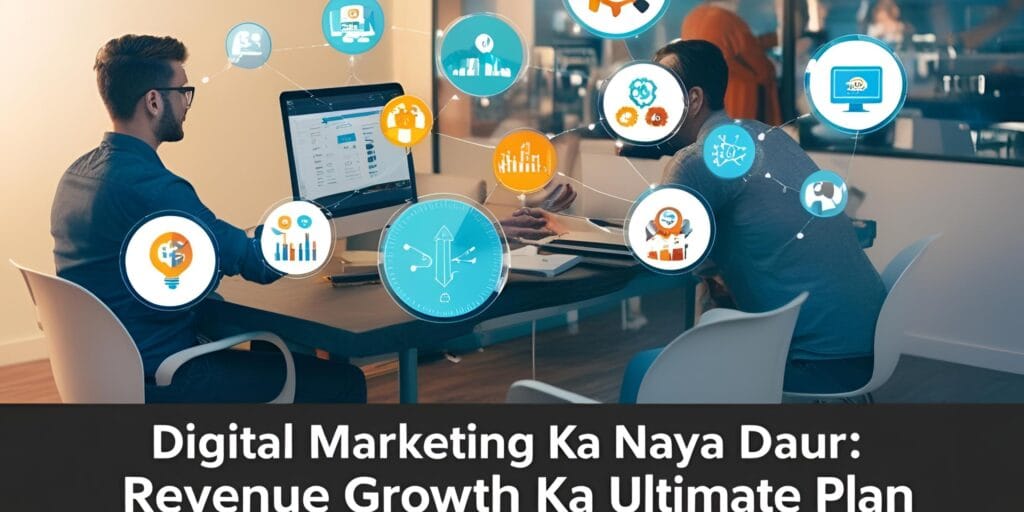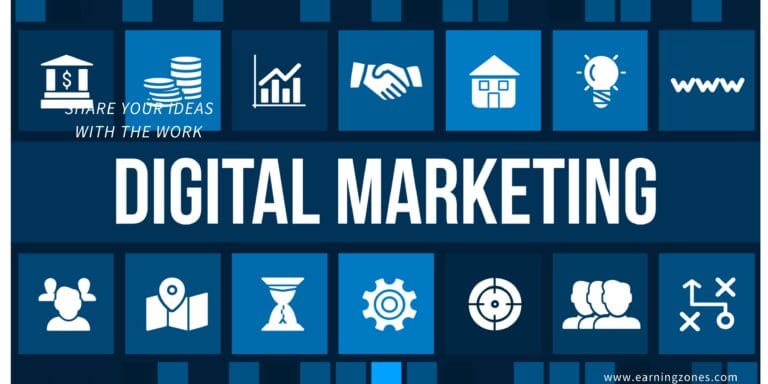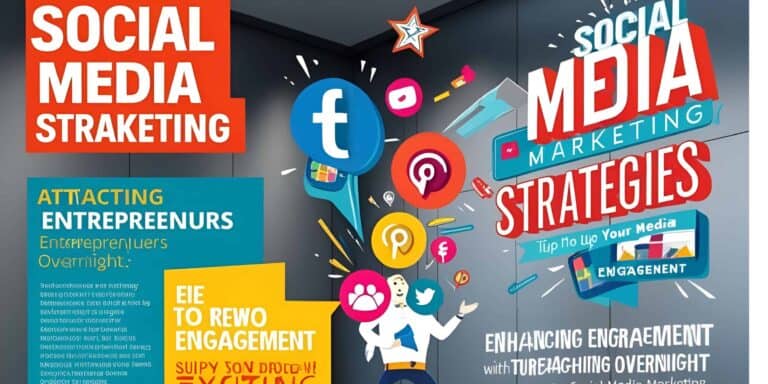The New Era of Digital Marketing: The Ultimate Plan for Revenue Growth
Digital Marketing: Growing a business in today’s digital age is not an easy task. However, when you have the right strategies, you can elevate your revenue to the next level. In this article, we will analyze the new era of digital marketing and discuss all the tactics through which you can dramatically increase your business’s revenue. Whether you are a small startup or an established business, these strategies will provide you with actionable insights and pave the way for your long-term success.Digital marketing consists of many components – SEO, social media marketing, paid ads, email marketing, and influencer collaborations. However, the right combination and consistent implementation of all these create the ultimate revenue growth plan. If we look closely, each strategy has its unique role that contributes to overall business growth. We will break down this article step-by-step so that you can understand each tactic well and implement it immediately.

1. SEO and Content Marketing: The Backbone of Organic Growth
In the digital marketing ecosystem, SEO (Search Engine Optimization) and content marketing form the backbone. These techniques drive organic traffic, build credibility, and ensure long-term revenue growth.
Comprehensive Guide to SEO
SEO involves optimizing your website for search engines. When done correctly, it helps Google and other search engines rank your site higher. The process starts with detailed keyword research to identify what your potential customers are searching for. For instance, if you sell digital products or services, target keywords like “best digital marketing tools” or “online marketing strategies.”
On-page SEO elements like meta titles, descriptions, proper headings, and internal linking play a significant role. Additionally, website loading speed and mobile responsiveness are crucial ranking factors. A great user experience encourages visitors to spend more time on your site, ultimately improving conversion rates.
Read more:
Content Marketing: Value-Driven Engagement
Content marketing allows you to provide valuable and engaging content to your audience through informative blogs, videos, infographics, and case studies. Consistent high-quality content establishes you as an authority, boosting organic trust and improving your website’s ranking.
Real-Life Example: A small SaaS company selling digital marketing tools published detailed tutorials and customer success stories on their blog. Their “how-to” guides and industry insights helped potential customers understand the product’s practical use. As a result, their website traffic steadily increased, and their conversion rate rose by 50%.
Detailed Execution Steps
- Keyword Research Tools: Use tools like Google Keyword Planner, SEMrush, or Ahrefs to identify keywords with manageable competition and high search volume.
- Content Calendar: Create a content calendar to plan topics and posting dates weekly or monthly. Consistency is key!
- Quality Over Quantity: Focus on high-quality, detailed content that addresses user queries. Generic content won’t create lasting impact.
- Backlink Strategy: Gain quality backlinks through guest blogging, influencer outreach, and industry partnerships to boost your site’s authority and search engine ranking.
Case Study: Revenue Increase Through Organic Growth
A local education startup integrated SEO and content marketing into their strategy. They targeted niche-specific long-tail keywords and published regular blog posts with detailed case studies, student testimonials, and practical tips. Result? Within nine months, their organic traffic increased by 400%, and revenue doubled. This example shows that consistent, well-researched content can drive long-term growth.
2. Social Media Marketing: From Brand Awareness to Direct Revenue
Social media platforms are a powerful tool in digital marketing. With active users on Facebook, Instagram, LinkedIn, and Twitter, businesses can leverage these platforms for brand awareness and direct revenue generation.
Platform Selection and Strategy
Each social media platform has a unique audience and style. For visual content, Instagram and Pinterest are ideal, while LinkedIn suits professional services. The key is selecting the right platform to connect directly with your target audience.
A carefully planned content strategy is essential. People prefer consistent, engaging content. Regular posts, interactive stories, reels, and live sessions help establish a strong connection with your audience. Authenticity and relatability are crucial, and leveraging trending topics or challenges can further boost engagement.
Engagement and Community Building
Social media marketing isn’t just about posting. Active engagement and community building are equally important. Responding to comments, interacting via direct messages, and considering follower feedback give your brand a human touch. This consistent engagement helps grow a loyal customer base.
Real-Life Example: A fashion startup posted daily creative reels or stories on Instagram, organizing contests and Q&A sessions. This strategy grew their followers from 10,000 to 50,000 in six months, significantly boosting website referral traffic and achieving 3X sales growth.
Detailed Steps for Social Media Success
- Content Calendar & Consistency: Create a platform-specific content calendar. Consistent posting aligns with algorithms.
- Visual Appeal: Use high-quality images and videos. Tools like Canva help create visually appealing content.
- Monitor Analytics: Track post performance using tools like Facebook Insights or Instagram Analytics to identify engaging content.
- Engage, Don’t Just Post: Actively reply to comments, messages, and shares to humanize your brand and build trust.
Case Study: From Zero to Hero
A local restaurant made social media marketing their primary strategy, sharing daily food pictures, behind-the-scenes videos, and customer testimonials on Instagram. Special discounts and event promotions rapidly increased their reach. This led to a 60% increase in footfall and 35% revenue growth, showing how creative, consistent engagement can directly impact revenue.
3. Paid Advertising and Retargeting: From Instant Traffic to Revenue Boost
When you need instant results alongside organic growth, paid advertising is a powerful tool. Platforms like Google Ads, Facebook Ads, and Instagram Ads drive targeted traffic that converts quickly.
How Paid Advertising Works
The first step is accurately defining your target audience—age, gender, interests, location, and online behavior. For example, to promote a fitness app, target health enthusiasts, gym-goers, or diet-conscious individuals.
Ad copy and creative elements are the heart of your campaign. Write crisp, engaging ad copy, use high-quality visuals, and include clear calls-to-action (CTAs). A/B testing helps identify the most effective ad versions for focused efforts.
Boost Conversion Rates with Retargeting
Retargeting is critical for re-engaging visitors who left your website without converting. Since people often compare options before deciding, retargeting ads remind them of their interest in your product or service, significantly improving conversion rates.
Detailed Execution Steps
- Budget Management: Set daily or monthly budgets to avoid overspending. Use effective bidding strategies to maximize ROI.
- Analytics Integration: Use Google Analytics and ad platform insights to identify high-performing campaigns and refine strategies.
- Seasonal & Event-Based Campaigns: Run dedicated campaigns during festive seasons or events for instant traffic and sales boosts.
- Clear Messaging: Highlight your value proposition in ad copy, emphasizing limited-time offers, discounts, or unique selling points to create urgency.
Case Study: Quick Wins Through Paid Ads
An online education platform launched a Google Ads campaign targeting keywords like “best online courses” and “affordable digital marketing training.” They also used retargeting ads to re-engage previous website visitors. The campaign increased their conversion rate by 4X, delivering immediate revenue impact. This shows that well-implemented paid advertising provides instant, measurable results.
4. Email Marketing and Automation: Drive Sales with Direct Connections
Email marketing is often underestimated but is a powerful strategy for building direct connections. Regular contact with potential and existing customers can convert them into loyal ones.
Email Marketing Breakdown
- Lead Magnets and List Building: Offer lead magnets like free eBooks, discount coupons, or webinars on your website to encourage email subscriptions. Lead magnets attract potential customers by providing valuable offers.
- Personalization and Segmentation: Avoid generic emails. Segment subscribers based on interests and behavior, sending personalized emails with their names, past purchases, or preferences to boost engagement.
- Automation and Drip Campaigns: Use tools like Mailchimp, ConvertKit, or ActiveCampaign to schedule welcome emails, nurture sequences, and newsletters. Drip campaigns deliver structured information, maintaining interest and improving conversion rates.
Real-Life Example and Case Study
A SaaS company launched a comprehensive email drip campaign for free trial users. They started with a welcome email explaining basic features, followed by step-by-step tutorials, customer success stories, and limited-time offers. Result? Their trial-to-paid conversion rate jumped from 30% to 70%, a direct result of personalized, timely email communication.
Detailed Execution Steps
- Regular Analysis: Monitor open rates, click-through rates, and conversion rates. Tweak subject lines or content for underperforming emails.
- Clear CTA: Include clear calls-to-action in every email, guiding users to the next step, like booking a demo or reading a blog.
- Interactive Elements: Add surveys, polls, or feedback forms to emails to boost engagement and gather valuable insights.
- Consistent Frequency: Sending one or two emails weekly maintains connection without overwhelming your audience.
5. Influencer and Affiliate Marketing: Skyrocketing Revenue Through Trust
In today’s digital era, people prefer authentic reviews and recommendations over traditional ads. Influencer and affiliate marketing are powerful tools that build trust and credibility for your brand.
Influencer Marketing: Authentic Brand Endorsement
- Choosing the Right Influencer: Select influencers closely aligned with your niche and with a genuine audience. Micro-influencers, with smaller but engaged communities, provide authentic reviews, maximizing organic reach.
- Campaign Strategy: Give influencers creative freedom while sharing brand guidelines. Their posts should feel natural and relatable to convey your product’s real value. Organizing contests or giveaways through influencers can also be highly effective.
Affiliate Marketing: Performance-Based Growth
In affiliate marketing, you engage third-party partners on a commission basis. This win-win model incentivizes affiliates while increasing your product or service exposure. Affiliates recommend your products to their audience, earning a commission per sale, adding a constant revenue stream to your sales funnel.
Detailed Execution Steps
- Clear Metrics & Tracking: Set clear metrics and use unique discount codes or affiliate links to measure traffic and sales generated.
- Regular Communication: Stay in touch with influencers and affiliates to optimize performance, sharing feedback and considering their suggestions.
- Long-Term Partnerships: Build long-term relationships rather than one-off campaigns for consistent promotions and sustained trust.
- Content Integration: Naturally integrate influencer posts into your brand story to avoid a hard-sell tone.
Case Study: Revenue Boost Through Influencer and Affiliate Marketing
A beauty products brand collaborated with micro-influencers and affiliate marketers. Influencers showcased the product in their daily routines, building trust with followers. Affiliates drove additional reach and sales. The campaign resulted in over 150% revenue increase, proving that leveraging authentic recommendations can skyrocket revenue.
FAQs
Q1: How important is mixing different digital marketing channels?
A1: Each channel has unique strengths. Combining SEO, social media, paid ads, email, and influencer marketing significantly boosts reach and conversions.
Q2: Is organic growth or paid advertising more effective?
A2: Organic growth builds long-term success and credibility, while paid ads deliver instant traffic and quick results. Balancing both is the best practice.
Q3: Is influencer marketing feasible for small businesses?
A3: Absolutely! Small businesses can run cost-effective campaigns with micro-influencers and niche-specific affiliates, delivering authenticity and engagement.
Q4: How does email marketing influence revenue growth?
A4: Email marketing builds direct, personalized connections. Consistent, targeted campaigns increase customer loyalty, driving repeat purchases and long-term revenue growth.
Q5: How do you manage budgets for paid advertising?
A5: Set daily or monthly budgets and use continuous A/B testing to identify the most effective campaigns. Retargeting campaigns also optimize budget efficiency.
Conclusion
The new era of digital marketing provides the tools and strategies to take your revenue to the next level. Whether it’s organic growth through SEO and content marketing, instant results from paid ads, social media engagement, email automation, or influencer collaborations, each tactic plays a unique role. This article explained each strategy with detailed insights, real-life examples, and case studies.
Consistent implementation of these strategies turns revenue growth from a dream into an achievable goal. Regular analysis, adapting to trends, and building genuine audience connections are key. Success in digital marketing is challenging but, with proper planning and execution, every challenge becomes an opportunity.
Now is the time to act! Create a holistic digital marketing plan for your business and watch your revenue skyrocket. Implement each strategy, gather feedback, and continuously refine your campaigns. This ultimate plan will help you stand out in a competitive market and achieve long-term success.
This detailed guide provides a step-by-step roadmap to grow your business revenue in the new era of digital marketing. Each section includes in-depth research and practical tips, offering a clear path forward. Boost your digital marketing efforts now and set new milestones for revenue growth!







